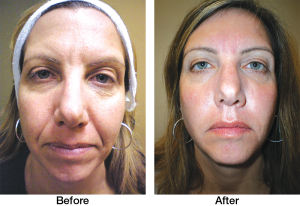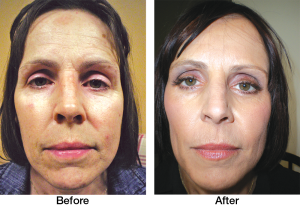Looking Your Best at Any Age
Advances in skincare products bring more choices to look good
By Deborah Jeanne Sergeant

Everyone wants to look his best. Thanks to today’s advances in skincare, local practitioners can help anyone improve his appearance. Twenty years ago, few options were available to help. Many topical treatments provided little, if any, noticeable improvement. The only other options were surgical, which offer effectiveness, but also increase the risk and expense.
Now, practitioners and their clients have more choices. Most agree that great looking skin starts with the most basic steps of home care.
For those showing signs of aging, it may seem too late to worry about sun screen; however, “introducing sun screen at any age will help your skin and make a huge difference in the quality of your skin,” said Shari Cardinale Bruzee, the owner of Dermatechnologies in Geneva. She is a licensed cosmetologist, certified medical esthetician and certified laser technician.
She said that many of her clients who are 55 and older feel that it’s too much trouble to use skin care products.
“You don’t have to spend three hours getting ready though,” she said.
Cardinale Bruzee tells clients that simply using daily a good moisturizer, cleanser, and exfoliating product represent a solid regimen to help skin of any age look healthier, along with eschewing chemical-laden make-up in favor of natural, mineral-based products.
“The moisturizer should be SPF 30 and no less,” Cardinale Bruzee said.
Sun screen products should contain titanium dioxide and/or zinc oxide for maximum effectiveness.
Beyond regular home care, she said advises clients to address any skin issues that bother them. Most clients list fine lines and wrinkles, sagging and dark spots. Retinol and retin-A have become popular for promoting the turnover of cells and the emergence of brighter, younger-looking skin.
Cardinale Bruzee prefers retinol over retin-A for its gentleness. Both derive from vitamin A; however, retinol “will, long-term, give you the same results as the retin-A without the redness and dryness.”

She also recommends dermal rolling as a home care modality for tightening skin. She said that it’s a manual tool that helps skin produce more collagen without using products.
“Over the course of a year, someone will look quite a bit younger after using it,” Cardinale Bruzee said.
If these methods don’t deliver the results clients want, she offers tightening through using peels, facials, laser treatments and microderm abrasion to stimulate cell turnover.
Some clients want a particular spot lightened, for example; others opt for quarterly maintenance to keep their skin tighter, lighten dark circles, lessen the appearance of broken capillaries.
Cardinale Bruzee felt surprise as a laser peel tightened her jowl and neck area, which becomes “a big target area” for people 55 and over, she said.
Laser treatments require no recovery time, and “no one will know you did it,” Cardinale Bruzee said. “You’ll have two days where you’ll be a little red, and then a very faint micro peeling. You could completely hide it with mineral make-up. It helps to heal the skin after treatment, too.”
Elizabeth Arthur, board-certified dermatologist and owner of Helendale Dermatology and Medical Spa in Rochester, said that aestheticians pay attention to lost volume in the aging face as well as lines. Facelifts alone only tighten skin.
“Sometimes you do have to pull skin, but tight skin doesn’t often make you look younger,” Arthur said. “It’s just tight, old skin. Even after patients do a facelift, we still have to revitalize them.”
Arthur explained as one ages, the face loses volume and sags down to the chin. Fillers can help balance the face, lift some sagginess, while retaining its softness.
“Nationally, the demand for facelifts is way down,” Arthur said. “It’s so invasive and expensive. People don’t just want to look tight. They understand that what makes their face look older and what’s happened.”
The American Society for Aesthetic Plastic Surgery reported 126,713 facelifts performed nationally in 2014, up from 99,196 facelifts in 1997. The growth isn’t as impressive when comparing the number of non-surgical cosmetic procedures, which grew by 508 percent, to only 82 percent growth among all surgical cosmetic procedures.
Combining Botox treatments with injected filler can offer non-permanent results, but Arthur said that’s what many clients want. Facelifts, though permanent, have scared some people as they see photos of celebrities’ procedures gone wrong.
“People want to look better, not different,” Arthur said.
The invasive nature of facelifts, along with the expense, also steer clients toward non-surgical procedures.
